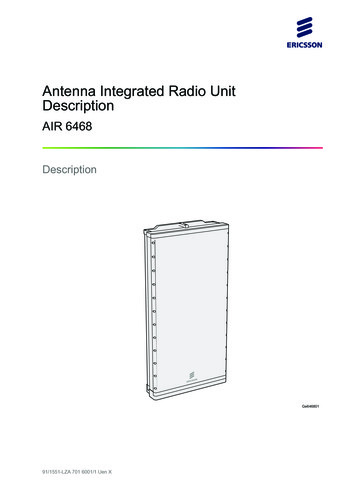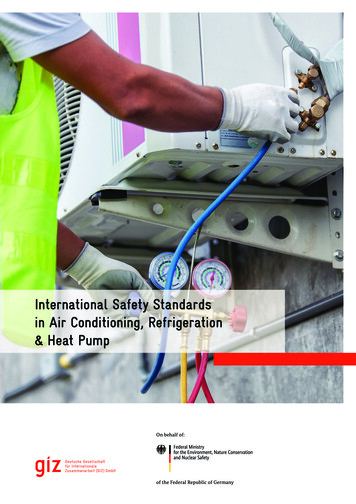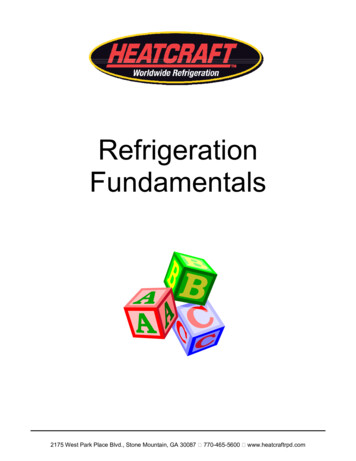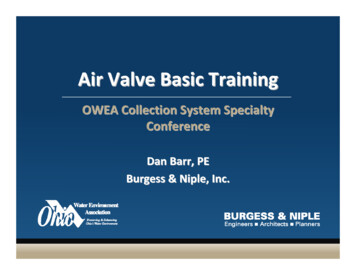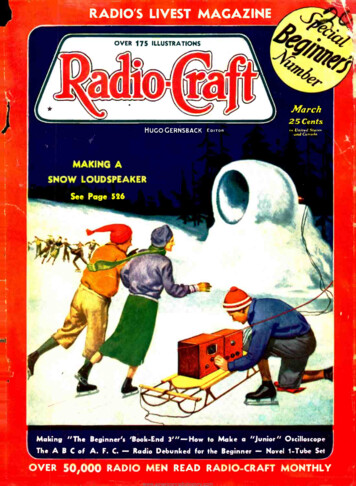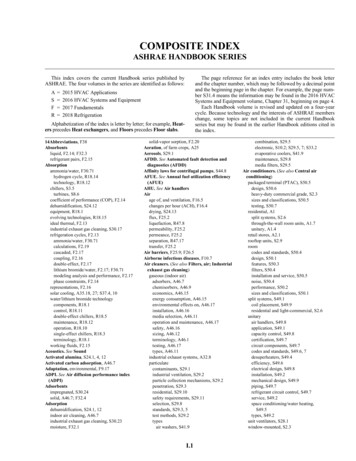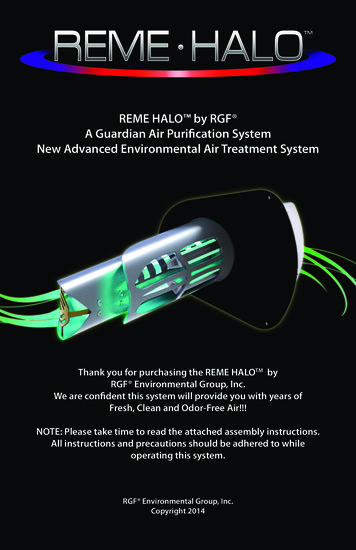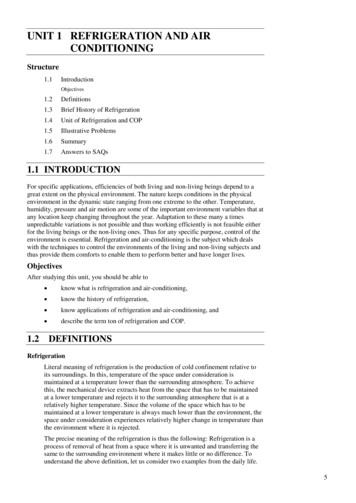
Transcription
UNIT 1 REFRIGERATION AND AIRCONDITIONINGRefrigeration and .2Definitions1.3Brief History of Refrigeration1.4Unit of Refrigeration and COP1.5Illustrative Problems1.6Summary1.7Answers to SAQs1.1 INTRODUCTIONFor specific applications, efficiencies of both living and non-living beings depend to agreat extent on the physical environment. The nature keeps conditions in the physicalenvironment in the dynamic state ranging from one extreme to the other. Temperature,humidity, pressure and air motion are some of the important environment variables that atany location keep changing throughout the year. Adaptation to these many a timesunpredictable variations is not possible and thus working efficiently is not feasible eitherfor the living beings or the non-living ones. Thus for any specific purpose, control of theenvironment is essential. Refrigeration and air-conditioning is the subject which dealswith the techniques to control the environments of the living and non-living subjects andthus provide them comforts to enable them to perform better and have longer lives.ObjectivesAfter studying this unit, you should be able to1.2 know what is refrigeration and air-conditioning, know the history of refrigeration, know applications of refrigeration and air-conditioning, and describe the term ton of refrigeration and COP.DEFINITIONSRefrigerationLiteral meaning of refrigeration is the production of cold confinement relative toits surroundings. In this, temperature of the space under consideration ismaintained at a temperature lower than the surrounding atmosphere. To achievethis, the mechanical device extracts heat from the space that has to be maintainedat a lower temperature and rejects it to the surrounding atmosphere that is at arelatively higher temperature. Since the volume of the space which has to bemaintained at a lower temperature is always much lower than the environment, thespace under consideration experiences relatively higher change in temperature thanthe environment where it is rejected.The precise meaning of the refrigeration is thus the following: Refrigeration is aprocess of removal of heat from a space where it is unwanted and transferring thesame to the surrounding environment where it makes little or no difference. Tounderstand the above definition, let us consider two examples from the daily life.5
Refrigeration and AirConditioningIt is a well-known fact that the spoilage of food and many other items reduces at alower temperature. At a lower temperature, molecular motion slows down and thegrowth of bacteria that causes food spoilage also retards. Thus to preserve manytypes of perishable food products for a longer duration, we use refrigerators(Figure 1.1) in our homes, canteens, hotels, etc. The temperature of the foodproducts has to maintained at a level below that of surroundings. For this we keepthe food products in a refrigerator. The inside volume of the refrigerator where westore food products or any other items is much less than the volume of the roomwhere the refrigerator is kept. The room in this case is the surroundingenvironment. Food products in the refrigerator initially were at a highertemperature than desired temperature, meaning that it had some unwanted heat. Ifits heat is removed, its temperature will decrease. The refrigerator removesunwanted heat from the food products and throws away that heat to the room – thesurrounding environment of the refrigerator. The amount of heat makes a bigdifference in temperature inside the refrigerator and almost little or no differencein the temperature of the room.Figure 1.1 : Spoilage of Food Products in a Refrigerator Slows Down. Temperature in the RefrigeratedSpace is Lower than the Room where Refrigerator is Kept. Refrigerator Throws AwayHeat from the Food Products to the RoomAs a second example let us consider travel in a car in an Indian summer of Delhi orKanpur. Outside temperature is very high. It is highly uncomfortable. For acomfortable drive, now-a-days we have air-conditioned cars. You will come toknow later, that refrigeration is an integral component of air-conditioning. To havea comfortable drive in the car, the temperature inside the car has to be loweredfrom about 40oC to 25 oC. This means that heat of the space inside of the car andits occupants has to be thrown outside. This is done by the refrigeration unit fittedin the car. The volume of the car is much less than that of the surroundings. Withthe rejected heat there is an appreciable change in the temperature inside the car,but no change in the temperature of the surroundings.In many places and situations, environment temperature is lower than thetemperature of the space that we desire. As an example consider car driving in theWinter of Delhi or Kanpur. Temperature outside is about 2-6oC. For a comfortabledrive with light clothing, temperature inside the car has to be about 25oC. Thismeans that heat has to be supplied or pumped inside the car and thus itstemperature has to be increased. The machinery that performs this operation isknown as heat pump. But in applications such as that of the comfortable driving ina car that depending upon the season requires temperature to be lower or higherthan the surroundings, heat has to be pumped to the car or rejected from the car.Since both the operations are performed by the same unit in the car, in a muchbroader sense we can say that a refrigeration unit controls the temperature of aspace. In the normal refrigeration system, this is done by reversing the operation.6
That is a refrigeration system can also be used as a heat pump.Refrigeration and AirConditioningFigure 1.2 : Journey in a Car is Comfortable if the Temperature Inside the Car is Maintainedat about 25 oC. To do so, in a Summer, Heat from inside the Car hasto be Rejected to the SurroundingsIn refrigeration, heat is pumped out from a lower temperature space to a highertemperature environment. We know from our experience in daily life that waterflows from a higher level to a lower level and heat flows from a body at a highertemperature to a body at a lower temperature. The reverse, i.e., flow of water froma lower level to a higher level and flow of heat from a body at a lower temperatureto a body at a higher temperature do not occur naturally. In practice these areachieved at the cost of external work (power) done on the water and the carrier ofheat (here the refrigerant) with help of a mechanical device.Whether the space under consideration has to be maintained at a temperature loweror higher than the surrounding environment, to pump out or in the heat, externalpower is always required. In relation to heat pump, this will be explained later.Figure 1.3 : Power is required to Pump Water uphill; the Same is true for PumpingHeat from a Lower Temperature Body to a Higher Temperature BodyAir ConditioningMerely lowering or raising the temperature does not provide comfort in general tothe machines or its components and living beings in particular. In case of themachine components, along with temperature, humidity (moisture content in theair) also has to be controlled and for the comfort of human beings along with thesetwo important parameters, air motion and cleanliness also play a vital role. Airconditioning, therefore, is a broader aspect which looks into the simultaneouscontrol all mechanical parameters which are essential for the comfort of human7
Refrigeration and AirConditioningbeings or animals or for the proper performance of some industrial or scientificprocess. The precise meaning of air conditioning can be given as the process ofsimultaneous control of temperature, humidity, cleanliness and air motion. In someapplications, even the control of air pressure falls under the purview of airconditioning. It is to be noted that refrigeration that is control of temperature is themost important aspect of air conditioning.To understand the above definition in a better way, let us consider one example. Inthe summer, the temperature in Delhi is about 10 oC higher than in Kolkata wheretemperature varies in the range of 32 oC to 35 oC. We feel uncomfortable in bothplaces. Weather in Delhi is hot and dry (moisture content in the air is low) whereasin Kolkata it is (mild) hot but humid (moisture content in the air is very high). Ifwe go to a hill-station, say Shillong in the summer, we feel comfortable there.Temperature there remains about 25 oC and relative humidity of the air is also inthe comfortable range, say about 65%. In Delhi, temperature is very high andhumidity is low, whereas in Kolkota, temperature is low but humidity is high. InDelhi if there is a rain, we feel more comfortable whereas in Kolkata even withrain, the relative comfort is less. In Delhi temperature falls down and humidity alsoincreases towards the comfortable value. In Koklata, temperature falls down buthumidity still remains on the higher side. Thus, for comfort, both temperature andhumidity have to be in the specified range. This is true for both human beings andscientific processes. Apart from the above two, from intuition one can also say thatpurity or cleanliness of the air is an essential item for the comfort and it has beenestablished that the air motion is also required for the comfort condition.Depending upon the requirement, air conditioning is divided into the summer airconditioning and the winter air conditioning. In the summer air conditioning, apartfrom cooling the space, in most of the cases, extra moisture from the space isremoved, whereas in the winter air conditioning, space is heated and since in thecold places, normally the humidity remains low, moisture is added to the space tobe conditioned. The summer air conditioning thus uses a refrigeration system and adehumidifier. The winter air conditioning uses a heat pump (refrigeration systemoperated in the reverse direction) and a humidifier. Depending upon the comfort ofthe human beings and the control of environment for the industrial products andprocesses, air conditioning can also be classified as comfort air conditioning andindustrial air conditioning. Comfort air conditioning deals with the air conditioningof residential buildings, offices spaces, cars, buses, trains, airplanes, etc. Industrialair conditioning includes air conditioning of the printing plants, textile plants,photographic products, computer rooms, etc.It has been mentioned above that the refrigeration and air conditioning are related.Even when a space has to be heated, it can be done so by changing the direction offlow of the refrigerant in the refrigeration system, i.e., the refrigeration system canbe used as a heat pump (how this is possible will be explained later). However,some section of the people, treat refrigeration exclusively the process that dealswith the cooling of the space. They treat heating operation associated with the heatpump. The relationship between air conditioning and refrigeration fields can beunderstood from the Figure 1.4.RefrigerationAir conditioningHeating,humidifying andcontrol of airqualityCooling anddehumidifyingoperation in airconditioningIndustrialrefrigeration includingchemical and processindustries, foodpreservationFigure 1.4 : Relationship between the Refrigeration and Air Conditioning8
Refrigeration and AirConditioningSAQ 1(a)Explain the term refrigeration.(b)Explain the term air conditioning.(c)How is refrigeration different from air conditioning?(d)How are refrigeration and air conditioning related?(e)How is summer air conditioning different from the winter air conditioning?1.3 BRIEF HISTORY OF REFRIGERATIONIn the past around 4000 years from now, people in India and Egypt are known to produceice by keeping water in the porous pots outside the home during the night period. Theevaporation of water in almost cool dry air and radiative heat transfer between the waterand the deep sky that is at a very low temperature (much below the freezing point of ice)caused the formation of ice even though the surrounding air was at a higher temperaturethan the freezing point of water. There are a few accounts in China about the use of icearound 1000 BC for cooling the beverages. In 4th century A.D., East Indians wereproducing ice by dissolving salt in water.Because of the very small amount of production, the aforesaid methods were not feasiblefor commercial applications. Natural ice is limited to certain regions, therefore, theabsence of good quality insulation systems in those days forced the man to developmethods to produce ice artificially. Out of many pioneers’ work on refrigeration side, afew are presented here. In 1790 the first British Patent was obtained by Thomas Harissand John Long. In 1834 Jacob Perkins developed a hand operated refrigeration systemusing ether as the working fluid (Figure 1.5). Ether vapor was sucked by the handoperated compressor and then high temperature and pressure ether vapor was condensedin the water cooled chamber that served as the condenser. Liquid ether was finallythrottled to the lower pressure, which was then evaporated in a chamber calledevaporator, A. With the evaporation, temperature of the water surrounding the evaporatorfell down and finally the ice was formed. In this system, either was used again and againin the cyclic process with negligible wastage.Figure 1.5 : Schematic of the Hand-Operated Refrigeration Machine of Jacob PerkinsThe first American patent of a cold air machine to produce ice in order to cure peoplesuffering from high fever was obtained by Dr. John Gorrie of Florida in 1851. In 1860,instead of air or ether, Dr. James Harrison of Australia used sulfuric ether. This was theworld’s first installation of refrigeration machine for brewery. In 1861, Dr. AlexanderKirk of England constructed a cold air machine similar to that of Dr. Gorrie. In his9
Refrigeration and AirConditioningmachine, air was compressed by a reciprocating compressor driven by a steam enginerunning on coal.In the 19th century, there was remarkable development of refrigeration systems to replacenatural ice by artificial ice producing machines. In the beginning of the 20th century, largesized refrigeration machines were developed. In 1904 in the New York Stock Exchange,about 450 ton cooling machine was installed. In Germany, people used air conditioningin theater. Around 1911 the compressors with speed between 100 to 300 rpm weredeveloped. In 1915, the first two-stage modern compressor was developed.To meet the demand for ice during the civil war, Ferdinand Carre of the USA developeda vapor-absorption refrigeration system (Figure 1.6) using ammonia and water. Carre’ssystem consisted of an evaporator, an absorber, a pump, a generator, a condenser and anexpansion device. The evaporated vapor is absorbed by the week ammonia-water mixturein the absorber yielding strong aqua ammonia. The pump delivers this strong solutioninto generator where heat transfer from a burner separates ammonia vapor and the weakammonia returns to the absorber. On the other hand the ammonia vapor condenses in thecondenser before being throttled. The throttled liquid ammonia enters the evaporatorresulting in completion of the cyclic process.Figure 1.6 : Vapor-Absorption Machine of Ferdinand CarreUntil about 1920s the development in refrigeration system was restricted to therefinement in the cold-air machines and vapor-compression systems. After 1920s, therehas been extensive diversification in the growth of refrigeration systems leading to newdevelopments such as vortex tube, thermoelectric, pulse-tube, steam-jet, centrifugalcompression systems, etc. The most important development can be the invention of newrefrigerants which were chlorfluor hydrocarbons. This development occurred in 1930 inGE Corporation of USA at a time when Refrigeration industry had begun to stagnate onthe use of NH3 SO2 as refrigerant. The chlorfluor carbons offered the advantages of bestrefrigerants and were proven non-toxic substances in comparison with NH3 and SO2Other developments took place due to special requirements to utilize waste heat or lowgrade energy or materials of specific properties for thermoelectric effect. Owing to thelikelihood of energy crisis in the future, many commercial units have been developed thatutilizes waste heat or solar energy.SAQ 210(a)Where is the first historical account of production of ice?(b)Why natural way of the ice production was not suitable for commercialapplications?(c)Trace the development of the modern refrigeration systems.
Applications of Refrigeration and Air ConditioningRefrigeration and AirConditioningThe fields of refrigeration and air conditioning are although interconnected, asshown in Figure 1.4, each has its own province too. The largest application ofrefrigeration is for air conditioning. In addition, refrigeration embraces industrialrefrigeration including the processing and preservation of food, removing heatfrom substances in chemical, petroleum and petrochemical plants, and numerousspecial applications such as those in the manufacturing and construction industries.In a similar manner, air conditioning embraces more than cooling. The comfort airconditioning is the process of treating air to control simultaneously its temperaturehumidity, cleanliness, and distribution to meet the comfort requirements of theoccupants of the conditioned space. Air conditioning, therefore, includes entireheating operation as well as regulation of velocity, thermal radiation, and qualityof air, including removal of foreign particles and vapors.Some applications of refrigeration and air conditioning are as follows :Air Conditioning of Residential and Official BuildingsMost of the air conditioning units are devoted for comfort air conditioning that ismeant to provide comfortable conditions for people. Air conditioning of building isrequired in all climates. In the summer, living/working spaces have to be cooledand in the winter the same have to be heated. Even in places where temperatureremains normal, cooling of the building is required to remove the heat generatedinternally by people, lights, mechanical and electrical equipment. Further in thesebuildings, for the comfort, humidity and cleanliness of air has to be maintained. Inhospitals and other medical buildings, conditions on cleanliness and humidity aremore stringent. There ventilation requirements often specify the use of 100 percentoutdoor air, and humidity limits.Industrial Air ConditioningThe term industrial air conditioning refers to providing at least a partial measure ofcomfort for workers in hostile environments and controlling air conditions so thatthey are favorable to processing some objects or materials. Some examples ofindustrial air conditioning are the following:Spot HeatingIn a cold weather it may be more practical to warm a confined zone where aworker is located. One such approach is through the use of an infrared heater.When its surfaces are heated to a high temperature by means of a burner or byelectricity, they radiate heat to the affected area.Figure 1.7 : An Infrared Heater is used to Heat a Confined Zone where a Worker is LocatedSpot CoolingIf a specific area has to be cooled, it will be unwise to cool entire room or factory.In this case, conditions may be kept tolerable for workers by directing a stream ofcool air onto occupied areas.11
Refrigeration and AirConditioningEnvironmental LaboratoriesThe role of air conditioning may vary from one laboratory to the other. In onelaboratory, a very low temperature, say – 40oC must be maintained to test certainequipment at low temperatures, and in another, a high temperature and humiditymay be required to study behavior of animals in tropical climates.PrintingIn printing industries, control of humidity is a must. In some printing processes thepaper is run through several different passes, and air conditioning must bemaintained to provide proper registration. If the humidity is not properlymaintained the problems of static electricity, curling or buckling of paper or thefailure of the ink to dry arise.TextilesLike paper, textiles are sensitive to changes in humidity and to a lesser extentchanges in temperature. In modern textile plants, yarn moves at very high speedsand any changes in flexibility and strength of the yarn because of the change inhumidity and temperature will thus affect the production.Precision Parts and Clean RoomsIn manufacturing of precision metal parts air conditioning helps to (a) keep thetemperature uniform so that the metal will not expand and contract, (b) maintain ahumidity so that rust is prevented and (c) filter the air to minimize dust.Photographic ProductsRaw photographic materials deteriorate fast in high humidity and temperatures.Other materials used in coating film also require a careful control of temperature.Therefore, photographic-products industry is a large user of refrigeration and airconditioning.Computer RoomsIn computer rooms, air conditioning controls temperature, humidity andcleanliness of the air. Some electronic components operate in a faulty manner ifthey become too hot. One means of preventing such localized high temperature isto maintain the air temperature in the computer room in the range of 20 to 23 0C.The electronic components in the computer functions favorably at even lowertemperatures, but this temperature is a compromise with the lowest comfortabletemperature for occupants. A relative humidity of about 65% is maintained forcomfort condition.Air Conditioning of VehiclesFor comfortable journey, planes, trains, ships, buses are air conditioned. In manyof these vehicles the major contributor to the cooling load is the heat from solarradiation and in case of public transportation, heat from people.Figure 1.8 : Air Conditioning is a must for a Computer Room12
Refrigeration and AirConditioningFood Storage and DistributionMany meats, fish, fruits and vegetables are perishable and their storage life canbe extended by refrigeration. Fruits, many vegetables and processed meat, suchas sausages, are stored at temperatures just slightly above freezing to prolongtheir life. Other meats, fish, vegetables and fruits are frozen for many months atlow temperatures until they are defrosted and cooked by consumer.SAQ 3(a)List some applications of air conditioning.(b)What are the temperature and humidity required for the comfort airconditioning?(c)Why is the air conditioning required in the computer room?(d)How refrigeration helps in the preservation of food products?(e)Why air conditioning is essential in preservation of photographic materials?(f)Why is air conditioning important for textile industries?1.4 UNIT OF REFRIGERATION AND COPThe standard unit of refrigeration is ton refrigeration or simply ton denoted by TR. It isequivalent to the rate of heat transfer needed to produce 1 ton (2000 lbs) of ice at 32 0Ffrom water at 32 0F in one day, i.e., 24 hours. The enthalpy of solidification of water fromand at 32 0F in British thermal unit is 144 Btu/lb. Thus2000 lb 144 Btu/lb24 hr 12000 Btu/hr 200 Btu/min1 TR In general, 1 TR means 200 Btu of heat removal per minute. Thus if a refrigerationsystem is capable of cooling at the rate of 400 Btu/min, it is a 2 ton machine. A machineof 20 ton rating is capable of cooling at a rate of 20 200 4000 Btu/min. This unit ofrefrigeration is currently in use in the USA, the UK and India. In many countries, thestandard MKS unit of kcal/hr is used. In the MKS it can be seen that12000 3024.2 kcal/hr3.968 50.4 kcal/min 50 kcal/min1 TR 12000 Btu/hr If Btu ton unit is expressed into SI system, it is found to be 210 kJ/min or 3.5 kW.Refrigeration effect is an important term in refrigeration that defines the amount ofcooling produced by a system. This cooling is obtained at the expense of some form ofenergy. Therefore, it is customary to define a term called coefficient of performance(COP) as the ratio of the refrigeration effect to energy input.COP Refrigerat ion effectEnergy inputWhile calculating COP, both refrigeration effect and energy input should be in the sameunit.13
Refrigeration and AirConditioningSAQ 4(a)What is ton of refrigeration?(b)What is refrigeration effect?(c)How is the COP of a refrigeration system defined?1.5 ILLUSTRATIVE PROBLEMSExample 1.1A refrigeration system produces 40 kg/hr of ice at 0oC from water at 25oC. Find therefrigeration effect per hour and TR. If it consumes 1 kW of energy to produce theice, find the COP. Take latent heat of solidification of water at 0oC as 335 kJ/kgand specific heat of water 4.19 kJ/kg oC.SolutionHeat removal rate to form 40 kg of ice at 0oC from water at 25oCQc sensible cooling from 25oC to 0oC latent heat of solidification of water 40 kg/hr (25 – 0) oC 4.19 kJ/kg. oC 40 kg/hr 335 kJ/kg 4190 kJ/hr 13400 kJ/hr 17590 kJ/hrRefrigeration effect (QC) 17590 kJ/hrWe know that 1 TR 210 kJ/min 12600 kJ/hrTherefore, TR equivalent to 17590 kJ/hr COP 17590kJ/hr 1.39612600kJ/hrRefrigeration effect17590kJ/hr 4.886Energy input1 3600 kJ/hrExample 1.2200 kg of ice at – 10oC is placed in a bunker to cool some vegetables. 24 hourslater the ice has melted into water at 50C. What is the average rate of cooling inkJ/hr and TR provided by the ice? AssumeSpecific heat of ice, cp,i 1.94 kJ/kg oCSpecific heat of water, cp,w 4.1868 kJ/kg oCLatent heat of fusion of ice at 0oC, L 335 kJ/kg.SolutionRate of heat addition to 200 kg ice at – 10oC to form water at 5oCQC (sensible heat gain of ice from – 10oC to 0oC latent heat of melting of ice sensible heat gain of water from 0oC to 5oC)/time (200 kg (0 – (– 10)) oC 1.94 kJ/kg. oC 200 kg 335 kJ/kg 200 kg (5 – 0) oC 4.1868 kJ/kg. oC)/24 hr 3127.78 kJ/hrCapacity 143127.78kJ/hr 0.248 TR12600kJ/hr
1.6 SUMMARYRefrigeration and AirConditioningIn this unit a brief introduction to the concept of refrigeration and air conditioning waspresented. Most of us are familiar with the household refrigerator which has become anindispensable part of our lives. This refrigerator is a perfect example of a mechanismutilizing the laws of thermodynamics in performing some useful work. Theserefrigerators work on the vapor compression refrigeration cycle which is the subject ofthe next unit. In the subsequent units, we will go into a deeper understanding of therefrigeration and air conditioning process from an engineering point of view.The subject of refrigeration can be better studied if we follow the progress made by therefrigeration industry through the ages. The student should be able to appreciate betterthe importance of refrigeration in our industries and also in our daily life after they havegone through this unit. This unit presents the basic terminologies and concepts associatedwith refrigeration and air conditioning. Subsequent units will build on these concepts anddevelop upon them. At the end of this unit, the student should be familiar with differentterms such as COP, ton of refrigeration and refrigeration effect. These terms are veryfrequently used in the study of the various refrigeration cycles and form the basis uponwhich a practicing engineer can decide on a refrigeration system depending upon theparticular needs.1.7 ANSWERS TO SAQsRefer the relevant preceding texts in the unit or other useful books on the topic listed inthe section “Further Readings” to get the answers of the SAQs.15
8 Refrigeration and Air Conditioning beings or animals or for the proper performance of some industrial or scientific process. The precise meaning of air conditioning can be given as the process of simultaneous control of temperature, humidity, cleanliness and air motion.


